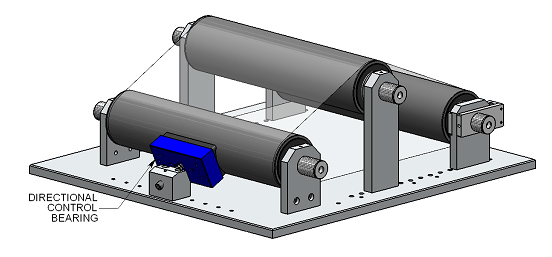SEMI’s Flex Conference 2017 wrapped up on Thursday, June 22, after four days of technology advancement and professional development at the Hyatt Regency in Monterey. The 16th annual edition of this conference reinforced its claim to be the best event in the industry, focusing on both technical and business interests in flexible, printed, and hybrid electronics applications.

Tim Claffey, Vice President of Sales
More than 625 professionals from 20 countries attended the 2017 conference. Flex featured 100+ presentations providing insight into relevant technologies, business strategies, and industry projections. Of course, New Way was there.
“The porous-media Air Turn technology that New Way offers provides significant advantages for roll-to-roll (R2R) film processing,” said Tim Claffey, New Way Vice President of Sales. “The non-contact handling that these Air Turns provide is particularly effective for coating applications, or processes that leave tacky surfaces.”
From Prototype to Production
New Way first attended the Flex Conference in Arizona exactly 10 years ago. Industry progress during that decade has been slow but steady. Acceleration now appears to be underway.
“In the last 10 years, we’ve watched the flexible display industry move from nascent technology to prototype, to on the verge of widespread production application,” Claffey said.
Need a Flex Conference 2017 Recap focused on R2R? That’s how we roll.
“Our primary interest is in providing non-contact, flexible-substrate handling capability,” Claffey noted. “Roll-to-roll technology, in particular, has evolved dramatically, and the industry itself has grown significantly since New Way first attended this event in 2008.”
With this in mind, the company views the recent conference through a very specific lens. Though there were scores of substantive presentations and five impactful short courses, New Way’s Flex Conference 2017 Recap features three plenary presentations, in particular, each involving R2R processing or inspection.
A Technology Roadmap
NovaCentrix Chief Marketing Officer Stan Farnsworth presented “Technology Roadmap: Trends and Needs in Printed and Flexible Electronics,” on behalf of the Organic and Printed Electronics Association (OE-A).
Farnsworth elaborated on the diversity of development platforms and technologies encompassed under “Printed and Flexible Electronics,” and the challenge this creates. He then reviewed one high-level solution, the recently released 8th edition of the Roadmap for Organic and Printed Electronics. This biannual OE-A compilation enhances tracking and refines industry development and need projections in application areas including OLED Lighting, Organic Photovoltaics, Flexible Displays and OLED, Electronics and Components, and Integrated Smart Systems.
Manufacturing Inflection Points
Dr. Mani Thothadri, Senior Director of New Business and Strategic Initiatives in the Materials Display and Flexible Technology group for Applied Materials presented: “Roll-to-Roll Processing Inflections for the Display & IoT Industry.”
Thothadri covered how next-generation consumer electronics devices are increasingly requiring flexible form factors which, in turn, necessitate polymeric film substrates. Most of these materials are manufactured in roll form, so there has been a corresponding acceleration in the utilization of R2R processing. According to Thothadri, this trend also compresses manufacturing line configurations, reducing cleanroom and materials costs.
This presentation was germane to New Way because of the advantages that the company’s non-contact air turns can provide in such compressed configurations, enabling concurrent processing of both sides of even a tacky substrate without the defects that contact often causes.
Inline Inspection
Dr. Erik Novak, Director of Business Development at 4D Technology, presented on “High-speed, high-resolution 3D metrology for improved process control of flexible electronic substrate production.”
Echoing Claffey’s earlier assessment, Novak noted that flexible electronics are now nearing scaled production. So the manufacturing focus has shifted towards producing higher yields, product longevity, and superior performance. This necessitates what Novak calls ‘in-situ metrology’ to allow real-time process control of key R2R production parameters, including surface roughness, defect density, and defect size.
New Way is particularly interested in the real-time measurements Novak describes “from within the roll-to-roll processing equipment” because the company already manufactures air bearings that support similar processes in the Flat Panel Display industry.
Enabling Technology for R2R Processing
One of the primary takeaways from this Flex Conference 2017 recap is that R2R is the enabling technology for commercial-scale Flexible Hybrid Electronics production. And the enabling technology for these R2R process systems must be non-contact.
New Way featured its standard 90, 180 and 270-degree Air Turns in the exhibit hall during this year’s conference. The company also exhibited its spherical bearings, demonstrating their use as a replacement for journal bearings in roller applications.
Contact New Way Today for Your Non-Contact R2R Application
If R2R is how you roll these days, and you’re looking for a non-contact processing solution, find out more. Download our ‘What Porous Media Air Bearings Can Do For You’ Infographic. This simple, visual tool provides a clear, concise rationale for considering Air Turns in your next application. Or, if you need non-contact capabilities right now, contact us directly today for your complimentary consultation!



